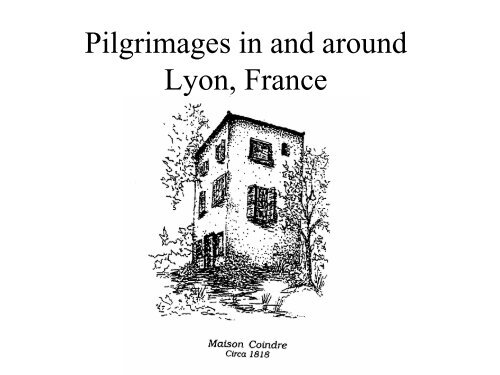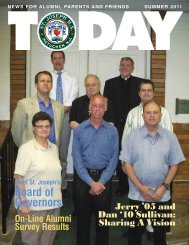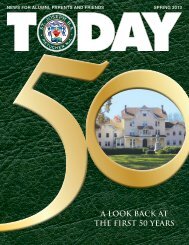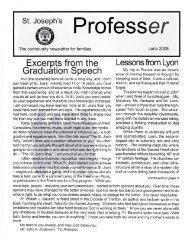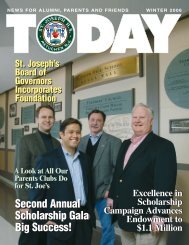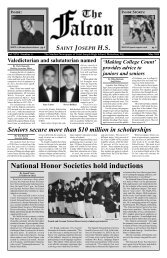Pilgrimages in and around Lyon, France
Pilgrimages in and around Lyon, France
Pilgrimages in and around Lyon, France
Create successful ePaper yourself
Turn your PDF publications into a flip-book with our unique Google optimized e-Paper software.
<strong>Pilgrimages</strong> <strong>in</strong> <strong>and</strong> <strong>around</strong><br />
<strong>Lyon</strong>, <strong>France</strong>
Right up the road from<br />
C.I.A.C. is le Chartreuse<br />
de <strong>Lyon</strong>, which conta<strong>in</strong>s<br />
the old church, St.<br />
Bruno’s (pictured here),<br />
as well as the compound<br />
area where the monks<br />
lived. The compound<br />
conta<strong>in</strong>ed a large<br />
cloister, garden,<br />
cemetery, small cloister,<br />
chapter room, <strong>and</strong> retreat<br />
chapel. Some of the<br />
build<strong>in</strong>gs date back to<br />
the late 1500’s.
Br. Marcel describ<strong>in</strong>g the<br />
<strong>in</strong>terior of St. Bruno’s.<br />
All the build<strong>in</strong>gs are <strong>in</strong><br />
need of major restoration,<br />
but the money to do that<br />
comes from the state, not<br />
the parishes, <strong>and</strong> the state<br />
is obviously reluctant to<br />
part with the money.<br />
Although over 80% of the<br />
people <strong>in</strong> <strong>France</strong> are<br />
Catholic, less than 10%<br />
are practic<strong>in</strong>g, so the<br />
churches are poorly<br />
funded.
Br. Ray <strong>in</strong> the pulpit<br />
where Father Andre<br />
Co<strong>in</strong>dre preached. St.<br />
Bruno’s is important to<br />
the Brothers of the Sacred<br />
Heart because their<br />
founder, Fr. Andre<br />
Co<strong>in</strong>dre, was a<br />
missionary there after the<br />
French Revolution. He<br />
was part of a large group<br />
of religious men <strong>and</strong><br />
women who tried to br<strong>in</strong>g<br />
religion back <strong>in</strong>to the<br />
lives of the French after it<br />
was prohibited by the<br />
government.
This is the view of <strong>Lyon</strong> from St. Bruno’s
This plaque at St. Bruno’s <strong>in</strong><br />
honor of Claud<strong>in</strong>e Thevenet.<br />
After Andre found the 2<br />
orphan girls, he turned to<br />
Claud<strong>in</strong>e to take them <strong>in</strong>, along<br />
with several others. Andre<br />
seemed to be <strong>in</strong>spired by<br />
Claud<strong>in</strong>e’s will<strong>in</strong>gness to help<br />
out these poor children, so he<br />
became her spiritual advisor.<br />
Shortly after that, he helped<br />
these women organize<br />
themselves <strong>in</strong>to an association<br />
<strong>and</strong> later a religious<br />
community called the<br />
Congregation of the Sacred<br />
Hearts of Jesus <strong>and</strong> Mary.
An early, manual silk loom. This is what Andre wanted the boys to<br />
learn how to do, <strong>in</strong> order to stay off the streets <strong>and</strong> out of jail.
A view of <strong>Lyon</strong> from near the C.I.A.C.
A view of <strong>Lyon</strong> <strong>and</strong> the Rhone River from the Brothers’ villa,<br />
(Petit Versailles), at la Procure
The Brothers’ garden at la Procure
The Brothers’ garden with a view
Some of the guys at the Procure B-B-Q:<br />
Don, Gerry, Greg, John, Ed, Br. Marcel, Br. Neri
The church of St. Nizier <strong>in</strong><br />
<strong>Lyon</strong> is where Andre Co<strong>in</strong>dre<br />
<strong>and</strong> Claud<strong>in</strong>e Thevenet were<br />
baptized. Many years later,<br />
Andre found the orphan girls<br />
ab<strong>and</strong>oned on the steps, which<br />
started everyth<strong>in</strong>g!<br />
* Note the dome over the ma<strong>in</strong><br />
entrance. It will be featured <strong>in</strong><br />
detail <strong>in</strong> the next slide.
Dome archway over the ma<strong>in</strong> entrance doors. The faces <strong>and</strong> images are<br />
all carved <strong>in</strong> relief <strong>in</strong> the stone.
St. John’s Cathedral was where Fr. Andre Co<strong>in</strong>dre was orda<strong>in</strong>ed.
This clock, <strong>in</strong> St. John’s<br />
Cathedral, was built <strong>in</strong> 1383.<br />
Although it has been<br />
damaged by wars <strong>and</strong><br />
revolutions, it has been<br />
repaired <strong>and</strong> now works! It<br />
st<strong>and</strong>s over 15 feet tall.
Close up of the clock face <strong>in</strong> St. John’s Cathedral
The town of Le Puy, where Paradis is located. Andre Co<strong>in</strong>dre purchased<br />
some property there <strong>in</strong> order to establish a place to tra<strong>in</strong> the Brothers.
In the foreground are old, orig<strong>in</strong>al build<strong>in</strong>gs of Paradis, which are now<br />
closed. Ris<strong>in</strong>g up <strong>in</strong>to the sky is a giant statue of St. Joseph. The<br />
Brothers still own a few acres of l<strong>and</strong> there, <strong>and</strong> the build<strong>in</strong>g they now<br />
use is a retirement place for the Brothers of <strong>France</strong>.
The cemetery at La Puy, with lavender <strong>and</strong> herbs grow<strong>in</strong>g everywhere.
A memorial to Fr. Andre<br />
Co<strong>in</strong>dre <strong>and</strong> other<br />
Brothers of the Sacred<br />
Heart (at Paradis)
Mount St. Michael was built over 1,000 years ago on top of a volcanic<br />
rock formation. The town’s name, Valay, is a term for the volcanic<br />
pillars that rise up <strong>in</strong> the area. There is no vehicle road access to the top.<br />
The faithful who wish to attend services must climb up on foot.
Beautiful carv<strong>in</strong>g <strong>in</strong> a Jesuit church <strong>in</strong> Vals.
Chapel at Vals where early<br />
Brothers of the Sacred<br />
Heart made perpetual<br />
vows.
Ursal<strong>in</strong>e nuns’ chapel built <strong>in</strong> 1600’s <strong>in</strong> Monistrol.
Monistrol
A back view of Fourvieve,<br />
which came <strong>in</strong>to our view after<br />
we climbed nearly 900 steps!<br />
Br. Ronnie led a group of us<br />
who wanted to make the climb<br />
by foot as Andre Co<strong>in</strong>dre would<br />
have. The rest of our group<br />
opted to take the bus.<br />
Fourvieve, mean<strong>in</strong>g “old forum”<br />
is so named because of the<br />
Roman ru<strong>in</strong>s found there.
Intricate carv<strong>in</strong>g near the entrance to Fourvieve. Construction was started<br />
<strong>in</strong> 1870 <strong>and</strong> completed <strong>in</strong> 1896.
Br. Ray say<strong>in</strong>g mass <strong>in</strong> the<br />
chapel at Fourvieve. This<br />
particular chapel was where<br />
many of the Brothers made<br />
their vows.
All the Brothers (<strong>and</strong> one Sister) on the altar, renew<strong>in</strong>g their vows.
A view of <strong>Lyon</strong> from the top of Fourvieve. The two follow<strong>in</strong>g slides<br />
complete the panorama from right to left.
The middle slide of the panorama of <strong>Lyon</strong>.
The far left slide <strong>in</strong> the panorama.<br />
The visibility on this day was over 50 miles.
The ma<strong>in</strong> Basilica of Notre<br />
Dame (at Fourviere). The<br />
church was built by the<br />
fathers of <strong>Lyon</strong> as<br />
thanksgiv<strong>in</strong>g because city<br />
was saved from <strong>in</strong>vasions.<br />
The vaulted ceil<strong>in</strong>gs soar<br />
100 feet overhead <strong>and</strong> are<br />
covered with <strong>in</strong>tricate <strong>and</strong><br />
beautiful mosaics.<br />
(this is a scanned postcard)
Fourvieve has many<br />
beautiful mosiacs on the<br />
walls <strong>and</strong> ceil<strong>in</strong>gs. This<br />
one is overhead <strong>in</strong> the<br />
ma<strong>in</strong> basilica.
The <strong>in</strong>terior of the<br />
Basilica of Notre Dame<br />
(Fourvieve)
A wall mosaic at Fourvieve.
The tomb of Claud<strong>in</strong>e Thevenet
Cluny, <strong>and</strong> the rema<strong>in</strong>s of the largest monastery <strong>in</strong> Christendom<br />
(187 meters at the time).
The Abbey at Cluny was founded <strong>in</strong> 909.<br />
The Church construction began <strong>in</strong> 1088.
Cluny, on the site of the<br />
monastery. Towards the<br />
end of the 12 th century,<br />
about 10,000 monks<br />
liv<strong>in</strong>g <strong>in</strong> 1,200 abbeys<br />
were affiliated with the<br />
Cluny Abbey, (with<br />
1,000 monks liv<strong>in</strong>g <strong>in</strong><br />
the Cluny Abbey itself).<br />
The homes <strong>in</strong> the town<br />
were built from the<br />
stones of the Abbey<br />
Church after if fell <strong>in</strong>to<br />
ru<strong>in</strong>s dur<strong>in</strong>g the<br />
Revolution.
Cluny
The town of Paray le Monial, pop. 12,000, is an important pilgrimage<br />
center <strong>and</strong> a shr<strong>in</strong>e to Christianity, as well as a charismatic center.
St. Claude’s at Paray le Monial
A beautiful mosaic <strong>in</strong><br />
St. Claude’s<br />
(Paray le Monial)<br />
The town is of <strong>in</strong>terest<br />
to the Brothers of the<br />
Sacred Heart because<br />
the Visitation Chapel<br />
is where the Sacred<br />
Heart appeared to<br />
Sister Margaret Mary<br />
(she was later made a<br />
sa<strong>in</strong>t). Follow<strong>in</strong>g this<br />
visitation, Sister M.M.<br />
spread the good news<br />
<strong>and</strong> the message of the<br />
Brothers.
A beautiful sta<strong>in</strong>ed glass<br />
w<strong>in</strong>dow <strong>in</strong> St. Claude’s<br />
(Paray le Monial)
The church <strong>in</strong> La Motte, the small town where Br. Polycarpe was born
This plaque <strong>in</strong> La Motte is dedicated to Br. Polycarpe, who is considered<br />
the second founder of the Brothers of the Sacred Heart.
The ancient ru<strong>in</strong>s of <strong>Lyon</strong> near<br />
Fourvieve. The amphitheater<br />
overlooks the city. The ru<strong>in</strong>s<br />
date back to 43 B.C.<br />
(postcard).
95<br />
Ancient ru<strong>in</strong>s <strong>in</strong> <strong>Lyon</strong> (postcard)
“Teach<strong>in</strong>g Christ”<br />
This bronze statue was created by<br />
an alum of St. Bruno’s. It currently<br />
is displayed at C.I.A.C.
Father Andre Co<strong>in</strong>dre,<br />
founder of the Brothers<br />
of the Sacred Heart


